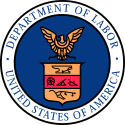Bureau of Labor Standards
The Bureau of Labor Standards was an agency of the U.S. Department of Labor from 1934 until 1971. It was the direct predecessor of the Occupational Safety and Health Administration.
History
The unit was formed as the Division of Labor Standards in November 1934, and renamed the Bureau of Labor Standards in 1948.[1][2]
Clara Mortenson Beyer was an early administrator of the Division.[3] In 1934, Molly Dewson and Frances Perkins encouraged Beyer to take the new position of Associate Director in the Division of Labor Standards. Beyer was excited about working in the new Bureau because she was eager to build an organization from the beginning. Beyer became an influential voice in New Deal era labor policies. Beyer, Perkins, and Arthur Altmeyer developed provisions that went into the Social Security Act of 1935.[4] Beyer working on American labor issues including apprenticeship, vocational education, and programs for elderly and migrant workers.[5] Perkins told Beyer that it was politically unrealistic for her to appoint another woman to a top job in an important Labor Department organization, otherwise she might have promoted Beyer further. Beyer apparently happily accepted this.[4]
Beyer's most recognized achievement at the Bureau of Labor Standards is her instrumental work towards the establishment of the Fair Labor Standards Act of 1938, which set minimum wage and maximum hour standards nationwide. Beyer's bureau helped Ben Cohen and Thomas Corcoran draft the legislation, and when Beyer herself was resisted by organized laborers who worried that minimum wage would lower wages overall, she worked with Congresswoman Mary T. Norton to lobby William Green, president of the American Federation of Labor. With his support, the law passed, and when the act was challenged and appealed to the Supreme Court, Beyer helped prepare the government's successful defense.[4]
Beyer served as Associate Director from 1934–1957, and Acting Director for 1957–1958.[5]
In July 1946, the Division absorbed the Industrial Division from the Children's Bureau.[1] Some tasks were added the Bureau's agenda by the Longshoreman's and Harbor Workers' Compensation Act of 1958.[6]
The Bureau became a component of the Wage and Labor Standards Administration when the latter was formed in 1967.[7] In 1971, the Bureau of Labor Standards became the Occupational Safety and Health Administration.[1][7]
References
- ^ a b c "Records of the Occupational Safety and Health Administration [OSHA]". National Archives. 2016-08-15. Retrieved 2020-12-25.
- ^ Goldberg and Moye, p. 170 and 201
- ^ Boris, Eileen. 2000. Beyer, Clara Mortenson. American National Biography Online, American National Biography Online.
- ^ a b c Susan Ware. 2004. Notable American Women: Completing the Twentieth Century. Beyer, Clara Mortenson.
- ^ a b Living New Deal. Clara Beyer (c.1892-1990).
- ^ Goldberg and Moye, p. 205
- ^ a b "General Records of the Employment Standards Administration [ESA]". National Archives. 2016-08-15. Retrieved 2020-12-25.
Bibliography
- The division's publications on labor standards, Bureau of Labor Standards, 1939.
- US Dept of Labor. A report on the Bureau of Labor Standards 30th anniversary. Bureau of Labor Standards bulletin 272. 1965.
- Joseph P. Goldberg, and William T. Moye. 1985. First hundred years of the Bureau of Labor Statistics. Bureau of Labor Statistics Bulletin 2235. U.S. Government Printing Office. ISBN 0-935043-01-2

